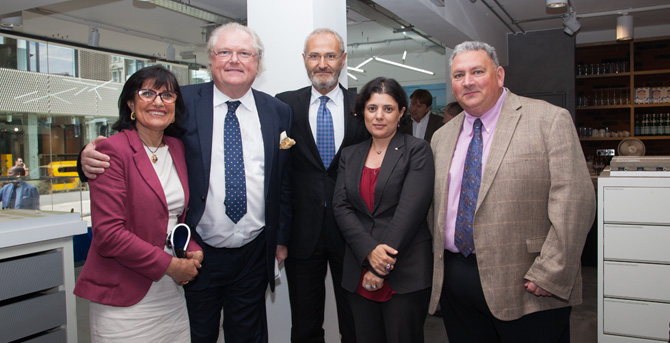Commercial properties make up an enormous portion of the built environment. They serve as a platform for most of the country’s major industries and provide the general public with areas in which to work, shop, socialise and relax. Needless to say, commercial buildings play a crucial role in 21st century Britain. However, despite investment in this booming sector being ever on the rise, commercial buildings are amongst some of the poorest performing buildings in terms of energy efficiency. Joe Bradbury, Editor of Building Specifier and MMC Magazine investigates the importance of efficiency, exploring what changes can be implemented in 2018 going forward in order to help achieve this goal.
According to the Committee on Climate Change, the commercial sector is accountable for approximately 26% of all greenhouse gas emissions from buildings in the UK. The world’s population is currently consuming the equivalent of 1.6 planets resources a year. The Global Footprint Network estimates that if we continue to consume at current rates we’ll blow the global carbon budget and lock in more than 2C of global warming in approximately 17 years.
As a result of this, the EU is currently reviewing its EU 2030 energy efficiency targets, with buildings in general highlighted as having great potential to reduce global emissions if efforts are made to make them more energy efficient.
How can we become more efficient?
There are so many things that commercial building owners and specifiers can do to become a little more eco-friendly, but in broad terms there is a 3-step process that should be followed in order to do so:
- significant investment in skills and capacity to enhance building management and deliver energy efficient refurbishment
- installation of low carbon generation capacity
- the design, manufacturing and fabrication of energy efficiency products and services
Heating and lighting are two areas in particular where changes need to be made. Let’s look at those two areas in more detail:
Light at the end of the tunnel
A cityscape at night is aesthetically a beautiful thing to behold; anybody who has seen the glowing lights of Vegas in the vast blackness of desert night, or London skyline reflecting on the surface of the Thames, will concur. Unfortunately, it is also an incredibly inefficient and irresponsible use of energy and a waste of precious resources. Overnight lighting is just one of many bad habits held by the commercial sector today. It is also one of the easiest to fix.
In 2013, France made it a legal requirement for shops and offices throughout the country to turn off their lights overnight in a bid to fight light pollution. This is expected to save 250,000 tonnes of CO2 per annum – roughly enough energy to power 750,000 French households for a year, according to the French Environment Ministry. So, if you want to reduce the carbon footprint of your building, put that light out!
Another easy but effective change that can be implemented immediately is to upgrade to LED lighting. It requires very little upfront investment, and delivers immediate returns.
Typically the energy savings made from switching from a conventional source to LED is 50-60%. They also require changing much less frequently, meaning that savings will also be made in terms of maintenance. This benefit is two-fold, affording the maintenance team the time to be more proactive in energy initiatives rather than changing lamps.
A recent California Energy Commission study also estimates that savings will be two times higher by the year 2020 by switching to LED than they are at present, when the technology becomes even more efficient.
A hot tip
The costs of heating and cooling a building are always on the rise. Often, addressing energy efficiency without a multi-system approach can be futile, with no tangible savings being made. Again, as with lighting, it is largely a behavioural change that will most benefit the commercial building sector in meeting efficiency targets going forward. For instance, a mere broadening of the range of temperatures inside your building, scheduling heating and lighting to vary according to peak occupancy times, can make drastic reductions to carbon footprint and energy bills.
Buildings are accountable for over 30% of final energy consumption in the world. 15% of this energy is used in the heating and cooling of interior spaces. Therefore it is imperative that you look at your heating and cooling systems if you want to make improvements.
Currently, the heating of buildings is largely based on fossil fuel burning technologies and cooling is dominated by incredibly carbon-intensive electrical systems. Studies suggest that by implementing low or zero-carbon heating and cooling methods in buildings – such as solar thermal, heat pumps, combined heat and power (CHP), and thermal energy storage – we have the potential to lower CO2 emissions by approximately 2 gigatonnes and save 710 million tonnes oil equivalent of energy over the next 34 years.
For many existing buildings, a change in the heating a cooling system and the building envelope accordingly can prove to be high in initial outlay and very disruptive. Some retrofits need a complete overhaul of their existing heating and cooling systems, insulation, windows etc. Sadly, the higher initial costs involved and the subsequent longer wait for financial return results in many buildings choosing to plod on using existing inefficient heating systems. This often hampers other energy efficiency efforts that have been made, making the strive for energy efficiency an earnest but ineffective endeavour.
Although it can be expensive, do not overlook the multitude of sustainable heating and cooling options on the market today. It is only through a multifaceted approach that the commercial building sector can truly make a tangible impact on its carbon footprint.
In summary
An efficient building is a productive building. By being considerate in how we generate and use energy, we can help reverse manmade climate change whilst simultaneously receiving a series of lucrative fringe benefits as an industry. We can also set an example for future generations to follow – ensuring that professionals within the built environment always have a healthy, vibrant environment in which to build for many years to come.















I can understand how a business could be more efficient in the right building. Having the right building made by a professional could be really useful. It is interesting to learn about how they can be more efficient with the right investment in schools.
You made a good point when you shared that it is important to be considerate of how we generate and use energy in order to have an efficient building. It is great to incorporate insulation when it comes to keeping your system from freezing and impact the whole operation. I would like to think if a company needs to improve its energy usage, it should consider installing insulating blankets by looking for a reliable service that can offer to install them.
It’s great to know that there are a lot of commercial heating systems in the market these days that are sustainable. I can imagine how the environment will also benefit from it if huge establishments will invest in them. Not only they will save money in the long run, the environment and the plant will probably improve when it comes to the global warming and climate change we are experiencing these days.